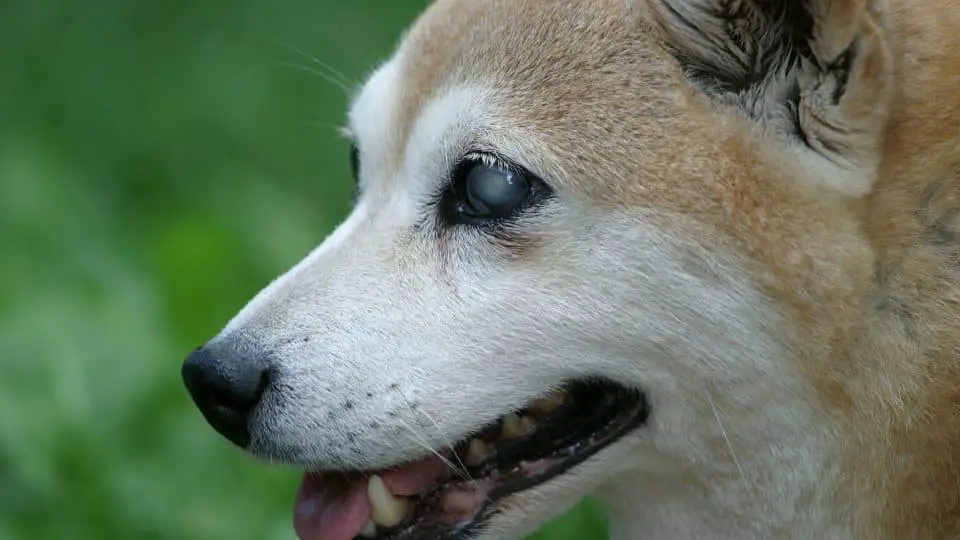Table of Contents
Just as glucose is the main source of energy in humans, the same applies to dogs too. To help with the conversion of glucose to energy, the insulin hormone is necessary. However, when a dog has diabetes, then this process is hindered. The increasing amount of glucose in the blood is what eventually leads to diabetes. Well, diabetes is no joke and can have adverse effects on a dog. It is why today we want to look at dog diabetes and blindness.
Signs that Your Dog has Diabetes

It is always better to learn about the signs of diabetes in your dog to take the necessary steps. Yes, diabetes can be managed and sometimes reversed if it is Type 2 diabetes. So, what are some of the signs that your dog might have diabetes?
The dog pees more frequently
This is the most common sign that the dog might have diabetes. You are likely to see puddles of dog pee all over the floor. Or when the dog seems to rush outdoors all the time to pee.
The increased urination is also called polyuria is the among the first signs that your dog is now insulin resistant. It is time to take your dog to a vet for more tests just to be sure.
The dog is thirstier than usual
Because the dog tends to urinate a lot more, it would be losing more fluids from its body. As a result, it will feel thirstier than usual. You should notice that the dog will be drinking its water more and more as compared to before. Most people know that a certain amount of water is enough to last the dog a few days, but when that changes, you should be aware that something is wrong.
Some dogs will have an absurd appetite
Studies show that a diabetic dog is likely to develop an insatiable appetite. This is because of the imbalance in the insulin hormone that controls blood sugar. Since there is lack of insulin, the dog would feel hungry most of the time. Such sends the signal to the dog that it is starving and thus it tends to eat all the time.
The dog starts to lose weight rapidly

Just so you know, rapid weight loss is not only associated with diabetes, but also other conditions. These conditions include cancer, liver disease, kidney disease, and gastrointestinal disease. Well, it is best to be sure that it is not diabetes by taking the dog to a vet for further examination.
A dog develops cloudy eyes
It is estimated that about 80% of the dogs with diabetes will develop cataracts to some degree. Sometimes such conditions can get worse, leading to blindness. If you start to see your dog with cloudy eyes, visit a vet for a checkup. If caught early, there are measures to alleviate this condition and help your dog get better.
The symptoms mentioned above are not the only ones that show your dog has diabetes. Whenever you notice something out of the ordinary, it is best to take your dog to the vet to establish what is wrong with it. Early detection of any disease can help control it with ease.
Risk Factors that Lead to Dog Diabetes?
Many things cumulatively lead to a dog having diabetes. Understanding these risk factors can help a lot in caring for your dog and keep it from getting diabetes. Here are some risk factors to look out for in any dog.
Autoimmunity
This happens when the body attacks its own tissues, thus destroying them. It is common when those cells that secrete insulin in the dog’s pancreas are destroyed. Since dogs depend on insulin coming from the pancreas, then more diabetes symptoms will start showing up. Autoimmunity is triggered by several things such as drugs, toxins, vaccination, food allergies, and other infections.
Dog breed
Unfortunately, some dogs are more prone to diabetes than others. If you own the following dog breeds, it is crucial to have them checked regularly for diabetes signs.
- Boxer
- Hungarian puli
- Golden retriever
- Finnish spitz
- German shepherd dog
- Chow chow
- Beagle
- Alaskan malamute
- Cairn terrier
- Doberman pinscher
This is not to say that other breeds not mentioned are safe from diabetes. You should always be keen about your dog to identify any diabetes symptoms as mentioned above.
GMO foods
The type of food that you give to your dog might have some effects too. If you are always feeding your dog with GMO food, then you risk it developing diabetes soon or later. GMO food contains several toxins that might end up affecting the various functionalities of the body organs.
Obesity

This is the number one cause of diabetes, whether in dogs or humans. It is estimated that more than half of dogs in the U.S are obese. With high levels of obesity, it is why we see more dogs having diabetes. Obesity simply increases the chances of insulin resistance, which ultimately leads to diabetes. It all comes down to the diet you give your dog. Still, if the dog does not exercise more often, it is likely to end up obese too.
Pancreatitis
We know that the pancreas is important for secreting insulin important for processing the sugar in the blood stream. When a dog has pancreatitis, then it would not produce enough insulin or any at all. The accumulation of too much glucose in the blood stream will lead to diabetes eventually.
Toxins
The introduction of toxins in the body of a dog can affect how various body organs work. Such toxins include aflatoxin, mold, vaccine, BPA, and much more. It is crucial that you watch what you give your dog, especially in terms of food.
How to Care for a Dog with Diabetes

Come up with the right plan for diabetes
Diabetes needs a proper and swift treatment. It comes down to the type of treatment plan you have with your vet. Talk to your vet to draft a treatment plan ideal for your dog. The sooner you begin treatment for the condition, the better you can help the dog. Ask any questions about the treatment plan just you make sure the dog gets all the right medication and on time.
You might have to use insulin shots
Depending on the severity of diabetes, you might have to use insulin shots for your dog. Insulin injections are used when the blood sugar is too high that other medications cannot handle it. Injecting insulin is easy after a few takes. Ask the vet to show you how to do the injection process. The last thing you want is to hurt the dog when giving it the insulin injection.
Do any follow up tests
Diabetes is generally a tricky disease. Sometimes you might have to do additional tests to see if the treatment is working. It is just like any other disease, as the treatment might take time to show any improvement. Sometimes these tests can be frustrating and expensive. If you are patient, you should start to see some improvements in your dog’s health.
Change the dog’s lifestyle
As explained earlier, the type of diet and other lifestyle choices can lead to having an obese dog and diabetes too. When it is confirmed that your dog has diabetes, dietary changes are essential. Talk to a vet who understands the condition so that you have an idea which diet would be ideal for your dog. The diet will vary a lot also depending on its age and breed. A bit of exercise might be essential to help keep your dog fit.
Below is a video on how to feed a diabetic dog for better health.
Monitoring the dog is essential
Diabetes can take a toll on the dog so monitoring it should be among your things to do. Because the dog might be thirsty most of the time, getting it to have water is essential. Also, use the glucometer device to draw blood and measure its glucose levels. It helps you know if the condition is improving or not.
Watch out for too much insulin
When the insulin levels get too high, it can also be dangerous to your pet. It is important that you adjust the insulin administered depending on the dog’s needs. Having too much insulin in the body leads to symptoms such as lethargy, dizziness, seizures, shaking, and falling.
How to Handle a Blind Dog

Diabetes is one of the reasons you might end up having a blind dog. Nevertheless, there are many other causes of blindness in dogs you should know about. They include the following.
- Cataracts
- Glaucoma
- Retinal detachment
- Corneal ulcers
- Progressive retinal atrophy
- Nervous system diseases
- Eye injuries
Whether the blindness was caused by diabetes or not, you still have to know how best to live with a blind dog in your home. Here is how you can do it.
Make the dog’s environment comfortable
The dog needs to be comfortable in its environment if it is going to adapt easily to living with blindness. Just know that it is not easy for it to adapt to these new changes. The dog will likely spend most of its time in a place that is familiar with it, so try to keep the home as comfortable as possible.
Remove hazards
It is important that you remove any obvious hazards from the dog’s path. Since the dog is blind, it will not easily navigate around some of the obstacles. Some of these hazards include sharp edges of table legs or coffee tables. Come up with ways to protect the dog from knocking into the edges.
Remove the children’s toys that might make the dog trip over. You could use rubber tubing to wrap around the sharp edges to keep them padded and soft.
Keep the furniture in its place
The dog is already familiar with the way the house looks, so it might be best if you kept the furniture the way it is to help it navigate the home. By changing the furniture location, you are likely to see the dog bumping into various obstacles easily.
Stop startling your blind dog
For a blind dog, it might be easily startled as it does not see what is coming towards it. As you can see, the dog is likely to get frightened when it is startled all the time. Whenever you approach a blind dog, make sure you have its attention first. You could call out its name first to let it know you are around it.
Training your blind dog

For this part, it is best to get a professional pet trainer. The dog might need additional training because it recently got blind. Once the dog has gone through the additional training, it will be easy to control it and even play games with it once again.
Preventing Dog Diabetes
Because you already know what causes diabetes, then it is all about doing the opposite to prevent dog diabetes. Considering that obesity is the most common trigger, it would be best if you kept your dog active. Do regular exercises to help the dog burn all those extra calories and help it maintain good health.
Well, exercising alone will not make a dog less susceptible to diabetes. The type of food that you give the dog is important too. Invest in a high-quality diet that gives the dog all the important nutrition that it needs to stay healthy.
Regular checkups at the vet are essential. People only take their dogs to a vet when they show signs of being sick. Sometimes it can be too late. It is best if you consider regular vet checkups to prevent diseases from getting worse. When diabetes is detected in its early stages, then you can easily deal with the condition and avoid dog diabetes and blindness.
Conclusion
Dog diabetes and blindness can be avoided if you take good care of your dog. Making sure that it gets high quality foods and has regular exercises are some of the things you can do. Always take precautions if you want your dog to stay healthy and maintain its eyesight. You could always take it to a vet for a checkup if you notice that it shows symptoms of diabetes. With proper management of the condition, you should still have a healthy dog on overall.
